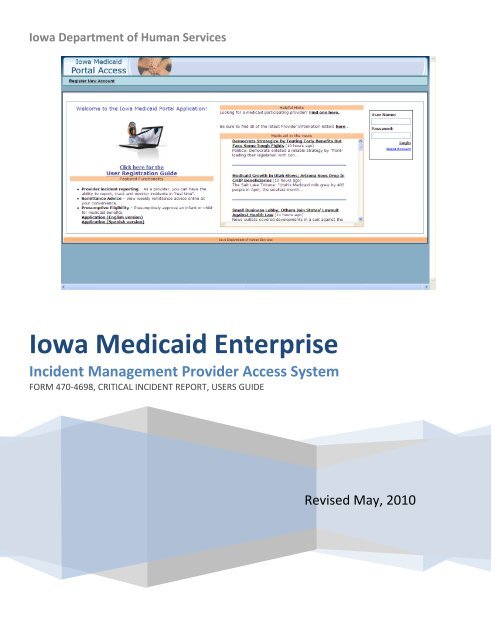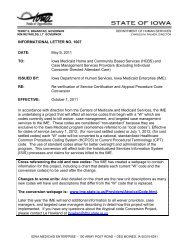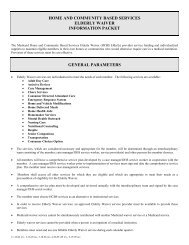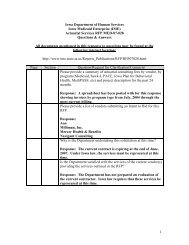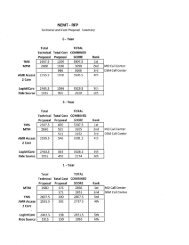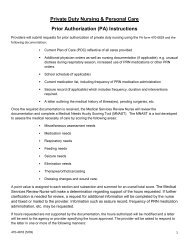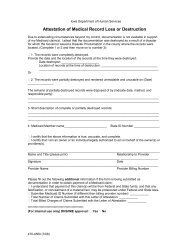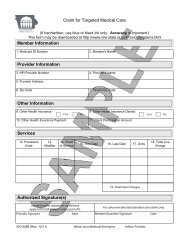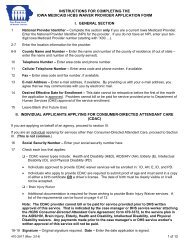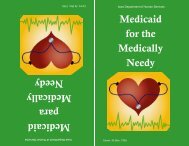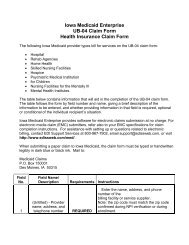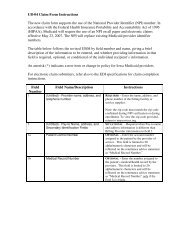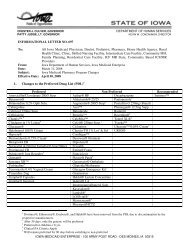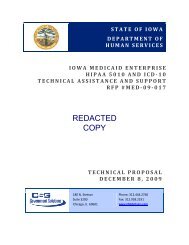Critical Incident Report User Guide Form 470-4698 - Iowa Medicaid ...
Critical Incident Report User Guide Form 470-4698 - Iowa Medicaid ...
Critical Incident Report User Guide Form 470-4698 - Iowa Medicaid ...
- No tags were found...
You also want an ePaper? Increase the reach of your titles
YUMPU automatically turns print PDFs into web optimized ePapers that Google loves.
<strong>Iowa</strong> Department of Human Services<strong>Iowa</strong> <strong>Medicaid</strong> Enterprise<strong>Incident</strong> Management Provider Access SystemFORM <strong>470</strong>-<strong>4698</strong>, CRITICAL INCIDENT REPORT, USERS GUIDERevised May, 2010
<strong>Iowa</strong> Department of Human ServicesIMPA <strong>Incident</strong> <strong>Report</strong>ing <strong>Form</strong>IMPA <strong>User</strong>s <strong>Guide</strong> – Revised May, 2010INTRODUCTION TO IMPAIMPA is the <strong>Iowa</strong> Department of Human Services’ <strong>Incident</strong> Management Provider Access system. IMPA has beendeveloped as a component of the Individualized Services Information System (ISIS). The <strong>Iowa</strong> Department of Inspectionsand Appeals, and other organizations, may have their own systems and requirements. This user’s guide will provide youwith all the information necessary to submit a major incident report to the <strong>Iowa</strong> <strong>Medicaid</strong> Enterprise (IME). The purposeof IMPA is to establish definitions, protocols, procedures and guidelines for the automated <strong>Incident</strong> ManagementSystem (IMS). The <strong>Incident</strong> Management System, for the purpose of this policy, means the consistent statewide processof identifying, classifying and reporting of major incidents, as well as conducting trend analysis reviews and reports ofthose incidents.Accessing IMPA on the World Wide Web through Internet Explorer, Firefox, Opera, Safari or Google Chrome providesefficient and timely communications for all participants throughout the state. As you work with <strong>Medicaid</strong> waivers,habilitation, or case management services, you will be provided with appropriate permissions to access the IMPAsystem. This will allow you timely access to the most current information regarding all cases that involve you. For thosewithout access to a personal computer, paper forms and instructions are available.The IMPA system will provide structure and a consistent, statewide system of incident reporting, trend analysis, and riskmanagement. This automation further refines existing policies and procedures that require incidents that bring harm, orhave the potential to bring harm, to members, are immediately and routinely identified and reported upon to assure themember’s health and safety. The end result will allow the implementation of measures that will prevent the recurrenceof similar incidents, along with other activities that allow providers to be proactive in their responsibilities to reduce therisk of harm to members. By identifying the underlying environmental and system factors that have contributed to anadverse event, the system attempts to find out exactly WHAT happened, WHY it happened, and HOW it can beprevented from happening again. The goal is prevention, both at the individual and systems level.Quality Improvement Process<strong>Incident</strong> <strong>Report</strong> MonitoringPage 3
<strong>Iowa</strong> Department of Human ServicesIMPA <strong>Incident</strong> <strong>Report</strong>ing <strong>Form</strong>IMPA <strong>User</strong>s <strong>Guide</strong> – Revised May, 2010INCIDENT REPORTINGThese incident reporting standards apply only to providers who have direct contact with members. The standards define“major” and “minor” incidents, and set procedures and prescribe the content of incident reports.MINOR INCIDENTS -- means an occurrence involving a member during service provision that is not a majorincident and that:1. Results in the application of basic first aid;2. Results in bruising;3. Results in seizure activity;4. Results in injury to self, to others, or to property; or5. Constitutes a prescription medication error.<strong>Report</strong>ing Procedure for Minor <strong>Incident</strong>s may be reported in any format designated by the provider. When a minorincident occurs or a staff member becomes aware of a minor incident, the staff member involved shall submit thecompleted incident report to the staff member’s supervisor within 72 hours of the incident. The completed report shallbe maintained in a centralized file with a notation in the member’s file.MAJOR INCIDENTS -- means an occurrence involving a member during service provision that:1. Results in a physical injury to or by the member that requires a physician’s treatment or admission toa hospital;2. Results in the death of any person;3. Requires emergency mental health treatment for the member;4. Requires the intervention of law enforcement;5. Requires a report of child abuse pursuant to <strong>Iowa</strong> Code section 232.69 or a report of dependent adultabuse pursuant to <strong>Iowa</strong> Code section 235B.3;6. Constitutes a prescription medication error or a pattern of medication errors that leads to theoutcome in numbered paragraph “1,” “2,” or “3”; or7. Involves a member’s location being unknown by provider staff who are assigned responsibility foroversight.<strong>Report</strong>ing Procedure for Major <strong>Incident</strong>sWhen a major incident occurs or a staff member becomes aware of a major incident:1. The staff member involved shall notify the following persons of the incident by the end of the next calendarday after the incident:a. The staff member’s supervisor.b. The member or the member’s legal guardian. EXCEPTION: Notification to the member is required onlyif the incident took place outside of the provider’s service provision. Notification to the guardian, if any,is always required.c. The member’s case manager.2. By the end of the next calendar day after the incident, the staff member who observed or first became awareof the incident shall report as much information as is known about the incident. The provider will report to thedepartment’s bureau of long-term care either:a. By direct data entry into the <strong>Iowa</strong> <strong>Medicaid</strong> Provider Access System, orb. By faxing or mailing <strong>Form</strong> <strong>470</strong>-<strong>4698</strong>, <strong>Critical</strong> <strong>Incident</strong> <strong>Report</strong>, according to the directions on the form.3. The following information shall be reported:a. The name of the member involved.b. The date and time the incident occurred.c. A description of the incident.Page 4
<strong>Iowa</strong> Department of Human ServicesIMPA <strong>Incident</strong> <strong>Report</strong>ing <strong>Form</strong>IMPA <strong>User</strong>s <strong>Guide</strong> – Revised May, 2010d. The names of all provider staff and others who were present at the time of the incident or whoresponded after becoming aware of the incident. The confidentiality of other members or non-memberswho were present must be maintained by the use of initials or other means.e. The action that the provider staff took to manage the incident.f. The resolution of or follow-up to the incident.` g. The date the report is made and the handwritten or electronic signature of the person making thereport.4. Submission of the initial report in IMPA will generate a workflow in ISIS for follow-up by the case manager.When complete information about the incident is not available at the time of the initial report, the providermust submit follow-up reports until the case manager is satisfied with the incident resolution and follow-up. Thecompleted report shall be maintained in a centralized file with a notation in the member’s file.5. Tracking and analysis. The provider shall track incident data and analyze trends to assess the health and safetyof members served and determine if changes need to be made for service implementation or if staff training isneeded to reduce the number or severity of incidents.FORM <strong>470</strong>-<strong>4698</strong>, CRITICAL INCIDENT REPORTOnce an incident has been identified as meeting thecriteria for a Major <strong>Incident</strong>, assure that the health andsafety of all individuals (member, staff and visitors) isaddressed immediately.The <strong>Critical</strong> <strong>Incident</strong> <strong>Report</strong>, <strong>Form</strong> <strong>470</strong>-<strong>4698</strong> consists offour distinct parts. Part 1, Initial <strong>Report</strong>, must becompleted and submitted by the end of the nextcalendar day following the incident.Best practices recommend that an incident report becompleted and submitted up to seven calendar daysfollowing an incident. If sections 2, 3 and 4 cannot becompleted because necessary investigative activitiesare not yet complete and / or resolution activities havenot been implemented, then the incident resolutionshould be updated and completed within 30 calendardays following the incident.The <strong>Critical</strong> <strong>Incident</strong> <strong>Report</strong>, <strong>Form</strong> <strong>470</strong>-<strong>4698</strong> can beused to record multiple incident types if they relate tothe same overall incident. If there are two distinctly separate incidents, two forms must be completed. The observer ofthe incident (or the staff involved) completes the <strong>Critical</strong> <strong>Incident</strong> <strong>Report</strong>, <strong>Form</strong> <strong>470</strong>-<strong>4698</strong> for any situation that meetsthe definition for a Major <strong>Incident</strong>. If the incident was not observed, the first person to become aware of the incident (orthe first staff to become aware) completes the report. When there is more than one member involved in the incident, areport will be completed for each member. The report for each member will focus on the actions of that person and thesteps taken by the provider on behalf of that person.Page 5
<strong>Iowa</strong> Department of Human ServicesIMPA <strong>Incident</strong> <strong>Report</strong>ing <strong>Form</strong>IMPA <strong>User</strong>s <strong>Guide</strong> – Revised May, 2010This guide will provide detailed information on each part and the sections within each part. Screenshots of the <strong>Critical</strong><strong>Incident</strong> <strong>Report</strong>, <strong>Form</strong> <strong>470</strong>-<strong>4698</strong> have been provided as well as a graphic representation for ease of navigation.Figure 1: <strong>Critical</strong> <strong>Incident</strong> <strong>Report</strong> <strong>Form</strong> <strong>470</strong>-<strong>4698</strong>PART 1 – INITIAL REPORTPart 1 must be completed and submitted by the end of the calendarday following the incident. Part 1 consists of four sections. Informationis completed on the:REPORTING PARTY: - The <strong>Medicaid</strong> provider (including casemanagement entities) who witnesses, or first becomes aware of theincident.MEDICAID MEMBER: - The waiver or habilitation recipient of serviceswho was involved in the incident.INCIDENT INFORMATION: - Information on the location, conditions,and involved individuals, as well as a short narrative, on thecircumstances surrounding the incident.IMMEDIATE RESOLUTION: Information on the assurance of health andsafety for all individuals involved.<strong>Report</strong>ingParty<strong>Medicaid</strong>MemberPart 1:Initial<strong>Report</strong><strong>Incident</strong>InformationImmediateResolutionThe REPORTING PARTY is the <strong>Medicaid</strong> provider (including case management entities) who witnesses, or firstbecomes aware of the incident. Fields in the reporting party section of the Initial <strong>Report</strong> include:Page 6
<strong>Iowa</strong> Department of Human ServicesIMPA <strong>Incident</strong> <strong>Report</strong>ing <strong>Form</strong>IMPA <strong>User</strong>s <strong>Guide</strong> – Revised May, 2010• NATIONAL PROVIDER IDENTIFIER (NPI): - The vendor identification number also referred to as the NPI (Nationalprovider identifier) for agency providers. For individual providers, the SSN (social security number) of the provider serves asthe vendor identification number.• PROVIDER (NAME OR AGENCY): - A person or business that provides medical services to a <strong>Medicaid</strong> member. The name ofthe agency or individual associated with the NPI or SSN should be entered.• PROVIDER ADDRESS, CITY, STATE, AND ZIP: - The provider’s main address (address, city, state, zip) should be entered.• COUNTY: County where provider’s main work center is located. In the case of an individual provider, the county would bethe county in which they reside.• PHONE #: - The provider’s phone number.• FAX #: - The provider’s phone number for receiving FAX transmissions.• REPORTER NAME (LAST, FIRST, MI): - The person completing the form. (Please note: If the incident report involves a childor dependent adult abuse referral, the reporter’s name, title and email address will not be entered into the IMPA system.)• REPORTER’S TITLE: - The title of the job position for which the person is employed. For an individual provider,the job which they perform. For example, an individual CDAC provider would enter “CDAC provider”.• REPORTER’S EMAIL: - The email address of the reporter.Figure 2: <strong>Medicaid</strong> Member, Part 1, Initial <strong>Report</strong>The MEDICAID MEMBER is the waiver or habilitation recipient of services who was involved in the incident. Fields inthe <strong>Medicaid</strong> member section of the Initial <strong>Report</strong> include:• MEDICAID NO: - Identification number assigned to the member consists of seven digits followed by a letter. Also knownas the State Identifier (SID) on ISIS screens.• MEMBER NAME (LAST, FIRST, MI): - The member’s legal name as associated with the <strong>Medicaid</strong> number.• MEMBER’S ADDRESS (ADDRESS, CITY, STATE, ZIP): - The address of the member’s primary resident. This must be a physicaladdress, not a post office box.• COUNTY: The county where the member lives.• DATE OF BIRTH: - The member’s birthday in mm/dd/yyyy format, where mm=month, dd=day, and yyyy=year.• MEMBER’S GENDER: - Select the correct gender for the member.• CASE MANAGER’S NAME (LAST, FIRST): - The name of the targeted case manager (TCM), HCBS case manager (HCBS-CM) or IDHS social worker (SW) assigned to provide oversight and monitoring of the member’s plan of care.• CASE MANAGER’S EMAIL: - The email address of the TCM, HCBS-CM or SW.• HCBS WAIVER: - Select the Home and Community Based Services Waiver in which the member is enrolled.• HCBS WAIVER ILL & HANDICAPPED: - The IH waiver provides services for persons who are blind or disabled. An applicantmust be less than 65 years of age.• HCBS WAIVER AIDS/HIV: - The AIDS/HIV waiver provides services for persons who have an AIDS or HIV diagnosis.• HCBS WAIVER INTELLECTUALLY DISABLED (formerly MR): - The ID (MR) waiver provides services for persons with adiagnosis of mental retardation.• HCBS WAIVER BRAIN INJURY: - The BI waiver provides services for persons who have a brain injury diagnosis due to anaccident or illness. An applicant must be at least one month of age but less than 65 years of age.• HCBS WAIVER PHYSICAL DISABILITY: - The PD waiver provides services for persons with a physical disability. An applicantmust be at least 18 years of age, but less than 65 years of age.• HCBS WAIVER ELDERLY: - People who are at least 65 years old may qualify for the elderly waiver program if they need anintermediate or skilled nursing level of care.Page 7
<strong>Iowa</strong> Department of Human ServicesIMPA <strong>Incident</strong> <strong>Report</strong>ing <strong>Form</strong>IMPA <strong>User</strong>s <strong>Guide</strong> – Revised May, 2010• HCBS WAIVER CHILDREN’S MENTAL HEALTH: - The CMH waiver provides services for children who have been diagnosedwith a serious emotional disturbance.• STATE PLAN HABILITATION: - Habilitation Services are designed to assist participants with chronic mental illness inacquiring, retaining and improving the self-help, socialization and adaptive skills necessary to reside successfully in homeand community-based settings.• GRANTS MFP: - The Money Follows the Person grant is utilized to expand services beyond what is currently offered underthe Intellectually Disabled and Brain Injury waivers to provide services to individuals transitioning into the community fromICF/MR’s.Figure 3: <strong>Incident</strong> Information, Part 1 Initial <strong>Report</strong>The INCIDENT INFORMATION section of the Initial <strong>Report</strong> collects information on the location, conditions, andinvolved individuals, as well as a short narrative, on the circumstances surrounding the incident.Figure 4: Date & Time of <strong>Incident</strong>, Part 1 Initial <strong>Report</strong>Fields in the <strong>Incident</strong> Information section of the Initial <strong>Report</strong> include information on the date and time of the incident:DATE AND TIME OF INCIDENT: - Enter the date and time that the incident was observed or discovered. Select either AMor PM.DISCOVERED: - Select this checkbox if the staff person discovers, or is told, of an incident but was not present,was not involved, or where the incident is suspected.Page 8
<strong>Iowa</strong> Department of Human ServicesIMPA <strong>Incident</strong> <strong>Report</strong>ing <strong>Form</strong>IMPA <strong>User</strong>s <strong>Guide</strong> – Revised May, 2010WITNESSED: - Select this checkbox if the staff person observed or was involved in the incident.• FIRST STAFF PERSON TO LEARN OF THE INCIDENT: - This person should be the witness or the discoverer of theincident (or the staff involved).STAFF TITLE: - The title of the job position for which the person is employed. For an individual provider, the jobwhich they perform. For example, an individual CDAC provider would enter “CDAC provider”.Figure 5: Location of <strong>Incident</strong>, Part 1 Initial <strong>Report</strong>Fields in the <strong>Incident</strong> Information section of the Initial <strong>Report</strong> include information on the location where the incidentoccurred. There are three possible responses:MEMBER’S HOMECOMMUNITYOTHER LOCATIONSelect only one. After choosing one location, provide additional information on that location by selecting more specificchoices under the location.MEMBER’S HOMEPRIVATE RESIDENCE/HOUSEHOLD – LIVING ALONE: - “Private household” means a dwelling unit occupied exclusivelyby the member and furnished by and belonging to them by reason of ownership, rental, or by a contract for purchase of lifeestate.PRIVATE RESIDENCE/HOUSEHOLD – LIVING WITH RELATIVES: - “Private household” means a dwelling unit occupied bypeople related to each other and furnished by and belonging to them by reason of ownership, rental, or by a contract forpurchase of life estate. “Relatives” means a person or persons, who constitute the members of the household and arerelated to one another by kinship of blood, marriage, or adoption.PRIVATE RESIDENCE/HOUSEHOLD – LIVING WITH UNRELATED PERSONS: - “Private household” means a dwelling unitoccupied by people unrelated to each other and furnished by and belonging to them by reason of ownership, rental, or by acontract for purchase of life estate.COMMUNITY SUPERVISED LIVING: - A building or place which provides residential and/or support services which would notconstitute a private household and is not licensed through the <strong>Iowa</strong> Department of Inspections and Appeals.RCF: - A residential care facility licensed by the <strong>Iowa</strong> Department of Inspections and Appeals.RCF/MR: - A residential care facility for the mentally retarded licensed by the <strong>Iowa</strong> Department of Inspectionsand Appeals.RCF/PMI: - A residential care facility for the mentally ill licensed by the <strong>Iowa</strong> Department of Inspections andAppeals.ASSISTED LIVING: - An assisted living facility licensed by <strong>Iowa</strong> Department of Inspections and Appeals.OTHER: - Select and describe in the narrative box.COMMUNITYCOMMUNITY JOB: - Unsupported employment in the community or supported employment with individualized servicesassociated with obtaining and maintaining competitive paid employment for individuals.SCHOOL: - An institution for the instruction of children or adults.DAY PROGRAM: - Organized program of supportive care in a group environment.WORK ACTIVITY: - Organized program of prevocational and work related activities in a group environment.Page 9
<strong>Iowa</strong> Department of Human ServicesIMPA <strong>Incident</strong> <strong>Report</strong>ing <strong>Form</strong>IMPA <strong>User</strong>s <strong>Guide</strong> – Revised May, 2010HOMELESS/SHELTER/STREET: - Lacking permanent housing or an establishment that provides temporary housing for thehomeless.VEHICLE: - A conveyance moving on wheels, runners, tracks, or the like, as a cart, sled, automobile, or tractor.SHOPPING: - Visiting shops and stores for purchasing or examining goods.DINING: - Eating a meal away from home as in a restaurant.RECREATING: - A pastime, diversion, exercise, or other resource affording relaxation and enjoyment.OTHER: - Select and describe in the narrative box.OTHER LOCATIONSTATE MHI: - State Mental Health Institutes in Cherokee, Clarinda, Independence and Mount Pleasant.STATE RESOURCE CENTER: - Glenwood and Woodward State Resource Centers.CORRECTIONAL FACILITY / JAIL: - A place for the confinement of persons in lawful detention.FOSTER CARE/FAMILY LIFE HOME: - “Foster care” means a single-family living unit in which an individual or a marriedcouple or a licensed facility provide room, board, and care for a child for a period exceeding 24 consecutive hours. “Familylifehome” means a private household offering a protective social living arrangement for one or two eligible adults who arenot able or willing to adequately maintain themselves in an independent living arrangement, but who are essentiallycapable of physical self-care.ICF / NURSING FACILITY: - Intermediate care (nursing) facility.ICF/MR: - Intermediate care (nursing) facility for the mentally retarded.ICF/PMI: - Intermediate care (nursing) facility for the mentally ill.HOSPITAL / MEDICAL CLINIC: - Facilities in which sick or injured persons are given medical treatment on an inpatientand/or outpatient basis.OTHER: - Select and describe in the narrative box.Figure 6: Others Present, Part 1 Initial <strong>Report</strong>Fields in the <strong>Incident</strong> Information section of the Initial <strong>Report</strong> include information on other people who were present atthe time the incident occurred. Enter the names of all provider staff present at the time of the incident or whoresponded after becoming aware of the incident in the narrative box. The confidentiality of other members or nonmemberswho were present must be maintained by the use of initials.OTHER MEMBER: - <strong>Medicaid</strong> member accessing any level or type of services.STAFF: - An individual or group of persons employed by the provider to perform specific tasks.FAMILY: - A person or persons who are related to the member by kinship of blood, marriage, or adoption.ROOMMATE: - A person with whom the member shares a room or living space.NEIGHBOR: - A person who lives near or next to the member.OTHER: - Select and specify the relationship in the narrative box.Figure 7: Services Being Provided, Part 1 Initial <strong>Report</strong>Page 10
<strong>Iowa</strong> Department of Human ServicesIMPA <strong>Incident</strong> <strong>Report</strong>ing <strong>Form</strong>IMPA <strong>User</strong>s <strong>Guide</strong> – Revised May, 2010Fields in the <strong>Incident</strong> Information section of the Initial <strong>Report</strong> include information on the services which were beingprovided at the time the incident occurred.SERVICES WERE NOT BEING PROVIDED: - Select this checkbox if services were not being provided at the timethe incident occurred.SERVICES WERE BEING PROVIDED AT THE TIME OF THE INCIDENT: - Select this checkbox if services were beingprovided at the time the incident occurred. Indicate the procedure code in the W CODE narrative box andprovide the SERVICE NAME of the service being provided in the narrative box.Figure 8: Narrative of <strong>Incident</strong>, Part 1 Initial <strong>Report</strong>Fields in the <strong>Incident</strong> Information section of the Initial <strong>Report</strong> require a written narrative of the incident being reported.Describe what happened before the incident including environmental conditions and any cues given. Describe theincident in observable and measureable terms. Describe what occurred after the incident and how long the incidentlasted.Figure 9: Immediate Resolution, Part 1 Initial <strong>Report</strong>Fields in the <strong>Incident</strong> Information section of the Initial <strong>Report</strong> require information on the immediate resolution of theincident, specifically the assurance of health and safety for all persons involved. There are ten resolution factors listed.Select all that apply.DATE OF IMMEDIATE RESOLUTION: - Enter the date that the health and safety of all persons involved wasassured.RESOLVED BY PROVIDER STAFF: - Staff actions to immediately protect person(s) from harm, to assure that theenvironment was safe, to provide first aid or seek emergency medical attention and to notify a supervisor.INCARCERATION: - Confined in lawful detention by law enforcement officers.OUT-PATIENT MENTAL HEALTH: - The treatment, assessment, or counseling of the member for a cognitive,behavioral, emotional, mental or social dysfunction in other than an in-patient setting.Page 11
<strong>Iowa</strong> Department of Human ServicesIMPA <strong>Incident</strong> <strong>Report</strong>ing <strong>Form</strong>IMPA <strong>User</strong>s <strong>Guide</strong> – Revised May, 2010IN-PATIENT HOSPITALIZATION (MEDICAL UNIT): - Emergency inpatient hospitalization of the member forunplanned medical procedures, including but not limited to: surgery, medical observation or testing.RESOLVED BY OUTSIDE ENTITY: - Resolution by a person for whom the member has no connection, associationor involvement such as a bystander.TREATMENT BY A HEALTH CARE PROFESSIONAL: - Any unplanned visit to a clinic or medical professional by themember for treatment of an injury, illness or medical condition.RESOLVED BY CASE MANAGER: - Resolution by the targeted case manager, HCBS case manager, or IDHS socialworker who is assigned oversight and monitoring of the member’s plan of care.RESOLVED BY NATURAL SUPPORTS: - Resolution by a person or persons in the community who providesupportive relationships such as a family member, classmates, peers, co-workers, places of business, religiousorganization, and community programs.EMERGENCY ROOM TREATMENT: - Emergency room treatment of the member for an injury, illness or medicalcondition for unplanned medical procedures, including but not limited to: observation, medical procedures ortesting.IN-PATIENT HOSPITALIZATION (MENTAL HEALTH UNIT): - Any unplanned admission to a medical facility by themember for treatment of a psychiatric condition.DESCRIBE THE ACTIONS TAKEN AFTER THE INCIDENT OCCURRED TO SECURE THE MEMBER’S SAFETY: - Underactions taken, stall will describe all actions taken to respond to or remediate the incident. Describe:1. Any staff actions to immediately protect the member or others from harm;2. Any immediate staff actions to make the environment safe;3. Any actions to provide first aid or seek emergency medical assistance; and4. Identify supervisors and/or other persons notified of the incident.GUARDIAN: - Guardian means the person appointed by the court to have custody of the member (or ward)under provisions of the Probate Code. (<strong>Iowa</strong> Code Chapter 633), or the parent of a minor child. Indicate if theguardian was notified of the incident.THIS IS THE END OF PART 1. THIS INFORMATION MUST BE SUBMITTED BY THE END OF THENEXT CALENDAR DAY FOLLOWING THE INCIDENT VIA THE IMPA OR FAXED PAPER FORMPART 2 – INCIDENT TYPEPart 2 gathers information on the specific type of incidentwhich has occurred. There are six categories of incidenttypes. Select all that apply.Part 2 may be completed with Part 1, or providers mayconduct an internal investigation consisting of interviewsand documentation review before completing Part 2.DeathMentalHealthLawEnforcementAbuse orRestrictionBest practices recommend that an incident report becompleted and submitted up to seven calendar daysfollowing an incident. If sections 2, 3 and 4 cannot becompleted because necessary investigative activities arenot yet complete and / or resolution activities have notbeen implemented, then the incident resolution should beupdated and completed within 30 calendar days followingthe incident.PhysicalInjuryPart 2:<strong>Incident</strong>TypeLocationUnknownPage 12
<strong>Iowa</strong> Department of Human ServicesIMPA <strong>Incident</strong> <strong>Report</strong>ing <strong>Form</strong>IMPA <strong>User</strong>s <strong>Guide</strong> – Revised May, 2010PHYSICAL INJURYFigure 10: Physical Injury, Part 2 <strong>Incident</strong> TypeThe Physical Injury section of the <strong>Incident</strong> Type consists of three steps. First, the reporter indicates whether the physicalinjury occurred to the member or by the member to another individual. Second, the specific type of injury is checked.Remember that the injury must require a physician’s treatment or admission to a hospital. If the member is taken formedical treatment but the health care professional does not indicate that an injury has occurred then the incident doesnot meet the requirements for a physical injury. If this is the case, do not complete the second step of the Physical Injurysection. Proceed on to other incident types.Step 3 of the physical injury section identifies specific factors surrounding the physical injury and will be explained laterin this guide.Figure 11: Physical Injury Circumstance, Part 2 <strong>Incident</strong> TypeComplete the Circumstances part by indicating whether the physical injury occurred to the member or was caused bythe member to another individual. Completion of this part is required before proceeding to the description of the injury.Select only one.Page 13
<strong>Iowa</strong> Department of Human ServicesIMPA <strong>Incident</strong> <strong>Report</strong>ing <strong>Form</strong>IMPA <strong>User</strong>s <strong>Guide</strong> – Revised May, 2010Figure 12: Physical Injury, Part 2 <strong>Incident</strong> TypeFields in Step 2 of the Physical Injury section of the <strong>Incident</strong> Type includes thefollowing selections. Please select all that apply.BURN: - An injury usually caused by heat but also by abnormal cold,chemicals, poison gas, electricity, or lightning, and characterized by a painfulreddening and swelling of the epidermis (first-degree burn), damage extendinginto the dermis, usually with blistering (second-degree burn), or destruction of theepidermis and dermis extending into the deeper tissue with loss of painreceptors (third-degree burn).DISLOCATION: - Displacement of a body part, especially the temporarydisplacement of a bone from its normal position.SPRAIN: - The condition resulting from a sprain that is usually markedby swelling, inflammation, hemorrhage, and discoloration. The sprain iscaused by a sudden or violent twist or wrench of a joint causing thestretching or tearing of ligaments. The tearing of muscle fibers or tendons(strain) due to overstretching would also fit under this category.ALLERGIC REACTION: - A local or generalized reaction to internal orexternal contact with a specific foreign substance, such as a protein or adrug, after a preliminary or sensitizing exposure. An allergic reaction maymanifest as a sharp drop in blood pressure, hives, rash or swelling of tissue,and breathing difficulties.CONCUSSION: - An injury to a soft structure, especially the brain,produced by a violent blow or impact and followed by a temporary,sometimes prolonged, loss of function. A concussion of the brain results intransient loss of consciousness or memory.CONTUSION / BRUISE: - An injury in which the skin is not broken, oftencharacterized by ruptured blood vessels and discolorations; a bruise.HUMAN / ANIMAL BITE: - A bite is a wound received from the mouth (andin particular, the teeth) of an animal, including humans.ABRASION: - The rubbing or scraping of the surface layer of cells or tissue from an area of the skin or mucousmembrane.LACERATION: - The process or act of tearing tissue such as a jagged wound or cut requiring sutures, use of dermabond, or staples.PUNCTURE WOUND: - A wound that is deeper than it is wide, produced by a narrow pointed object.FRACTURE: - A rupture, break, or crack, especially in bone or cartilage.ELECTRIC SHOCK: - The sudden stimulation of the nerves or convulsive contraction of the muscles accompanied by afeeling of concussion that is caused by the discharge through the body of electricity from a charged source.EYE EMERGENCY: - Cuts, scratches, objects in the eye, burns, chemical exposure, and blunt injuries to the eye oreyelid. Since the eye is easily damaged, any of these conditions can lead to vision loss if left untreated.LOSS / TEARING OF BODY PART: - Complete or partial traumatic amputation of a body part -- usually a finger,toe, arm, or leg -- that occurs as the result of an accident or trauma.LOSS OF CONSCIOUSNESS: - A state of impaired consciousness in which one shows no responsiveness toenvironmental stimuli but may respond to deep pain with involuntary movements.POISONING / TOXIN INGESTION: - Any substance taken internally or applied externally that is injurious to healthor dangerous to life.OTHER: - Select and describe the physical injury in the narrative box.Page 14
<strong>Iowa</strong> Department of Human ServicesIMPA <strong>Incident</strong> <strong>Report</strong>ing <strong>Form</strong>IMPA <strong>User</strong>s <strong>Guide</strong> – Revised May, 2010Figure 13: Physical Injury Due to a Mechanical Restraint, Part 2 <strong>Incident</strong> TypePage 15Step 3 of Physical Injury identifes the factorscontributing to the injury. Please select all that apply.MECHANICAL RESTRAINT means a device attached oradjacent to the member’s body that he or she cannoteasily remove that restricts freedom of movement ornormal access to his or her body.The following are not considered mechanical restraints for the purpose of this guide:a. Devices used to provide support for the achievement of functional body positions and equilibrium that havebeen prescribed by an appropriate health care professional;b. Stretcher belts, one piece safety belts, rail safety belts and transportation safety belts intended to prevent themember from accidentally falling;c. Equipment that does not restrict or prevent movement or the normal use/functioning of the body or body partsto which it is applied;d. Mechanical supports to provide stability necessary for therapeutic measures, such as immobilization offractures, administration of intravenous or other medically necessary procedures; and/ore. Car seats, high chairs, playpens or items generally used by parents and considered to be used for a child’sgeneral health and safety do not fall into this category, unless abuse, neglect or exploitation are suspected.Fields in the Physical Injury due to a Mechanical Restraint section of the <strong>Incident</strong> Type include:MECHANICAL RESTRAINT FOR BEHAVIORS: - Any use of a mechanical device attached to or in contact with themember’s body to restrict access to his or her body or to the environment to prevent or intervene with achallenging behavior.REMOVAL OF MOBILITY AIDS: - Removing the member’s mobility aids (wheelchairs, walkers, etc.) to prohibitfreedom/choice of movement.IMPAIR SENSORY CAPABILITIES: - Mechanical restraints that impair or inhibit visual or auditory capabilities orprevent, inhibit, or impair speech or other communication modalities.OTHER: - Select and describe the mechanical restraint in the narrative box.Figure 14: Physical Injury Due to a Physical / Manual Restraint, Part 2 <strong>Incident</strong> TypePHYSICAL / MANUAL RESTRAINT is the use of anyphysical or manual intervention used to restrictmovement of the member including, but not limitedto, holding the member’s body or limb(s) contingentupon behavior, or using an approved manual restraintprocedure (e.g. Mandt technique) so that movementis restricted or prevented for any amount of time.Please select all that apply.For the purposes of this guide, the following are not considered physical / manual restraints:a. Holding the member’s limb(s) or body to provide support for the achievement of functional body positions andequilibrium that have been prescribed by an appropriate health care professional;b. Holding a member's limb(s) or body as part of a specific medical, dental or surgical procedure that have beenauthorized by an appropriate health care professional; and/orc. Holding a member’s limb(s) or body to prevent the member from accidentally falling.Fields in the Physical Injury Due to a Physical / Manual Restraint section of the <strong>Incident</strong> Type include:
<strong>Iowa</strong> Department of Human ServicesIMPA <strong>Incident</strong> <strong>Report</strong>ing <strong>Form</strong>IMPA <strong>User</strong>s <strong>Guide</strong> – Revised May, 2010MOVEMENT INHIBITED: - Any restriction of physical movement in which the member remains on their feet or ina seated position for the purposes of controlling aggressive or agitated behavior.TAKE DOWN: - Gripping, handling and controlling of a member to bring the member into submission for thepurpose of gaining quick control due to aggression or agitation.PRONE RESTRAINT: - Physical holding of the member in a prone position, usually on the floor, for the purpose ofgaining quick control due to aggression or agitation. Prone restraint is the extended restraint past the time ofimmediate struggle.OTHER: - Select and describe the mechanical restraint in the narrative box.Figure 15: Physical Injury Due to Personal Harm, Part 2 <strong>Incident</strong> TypePlease select all that apply. Fields in the PersonalHarm section of the <strong>Incident</strong> Type include:AGGRESSIVE BEHAVIOR: - Overt orsuppressed hostility, either innate or resulting fromcontinued frustration and directed outward or againstoneself. Hostile or destructive behavior or actions.SELF-MUTILATION / SELF-INJURIOUSBEHAVIOR: - Behaviors that are harmful to oneself,including deliberate self-injury, such as hitting,oneself, or behaviors that indirectly cause injury orharm, such as repeatedly rubbing an area of skin untilit bleeds.SUICIDE ATTEMPT: - The member’s verbal,non-verbal or written threat to kill him/herself. An incident involving an act (attempt) to harm, injure or killoneself.PICA BEHAVIOR / INGESTION OF HARMFUL SUBSTANCE: - Swallowing and/or ingesting substances that are nonfoodand potentially threatening to the health of the member, e.g., plants, poison, lotions, coins, paper clips,cigarette butts (PICA behavior).ACCIDENTAL FALL: - Happening by chance or accident; not planned; unexpected. The act or instance of falling ordropping from a higher to a lower place or position.INGESTED / ASPIRATION / CHOKING: - The inhaling of food or other object in the lung (aspiration) orchoking.SEIZURE: - A sudden attack, spasm, or convulsion, as in epilepsy.VEHICULAR ACCIDENT: - When a road vehicle collides with another vehicle, pedestrian, animal, or geographicalor architectural obstacle. Any vehicular accident involving the member.ASSAULT: - A violent physical or verbal attack. Threatening or attempting to inflict immediate bodily harm that aperson has the ability to inflict and that puts the victim in fear of such harm or contact.OTHER: - Select and describe the personal harm in the narrative box.Figure 16: Physical Injury Due to an Environmental Condition, Part 2 <strong>Incident</strong> TypePlease select all that apply. Fields in the Environmental Conditionsection of the <strong>Incident</strong> Type include:FIRE: - Environmental hazards that place the member inimmediate jeopardy due to a fire.TORNADO / STORM: - Environmental hazards that placethe member in immediate jeopardy due to severeweather such as a thunderstorm or tornado.FLOODING: - Environmental hazards that place thePage 16
<strong>Iowa</strong> Department of Human ServicesIMPA <strong>Incident</strong> <strong>Report</strong>ing <strong>Form</strong>IMPA <strong>User</strong>s <strong>Guide</strong> – Revised May, 2010member in immediate jeopardy due to flooding.UNSAFE / UNHEALTHY PHYSICAL ENVIRONMENT: - Any edifice or space which does not provide a safe andhealthy environment. Conditions include, but not limited to, excess cold, excess heat, mold, pollutants, poor orinadequate sanitation or water supply, food safety, and environmental hazards such as electrical or gas.SOCIAL ENVIRONMENT: - Hazards from the social environment, which is the culture that the member waseducated and/or lives in, and the people and institutions with whom the member interacts. Social environmentconcerns would include familial and interpersonal relationship dysfunctions which jeopardize the health andwelfare of the member.OTHER: - Select and describe the personal harm in the narrative box.Figure 17: Physical Injury Due to a Medication Variance by Staff, Part 2 <strong>Incident</strong> TypePlease select all that apply. Fields in the MedicationVariance by Staff section of the <strong>Incident</strong> Type include:WRONG DOSAGE: - Incorrect dose, dosage form,quantity, route, concentration and / or rate ofadministration.WRONG MEDICATION: - Incorrect drug selection,contraindications, known allergies, and / orharmful interaction with existing drug therapy.WRONG TIME: - Medication administered early or late; and/or medication administered outside a predefinedtime interval from its scheduled administration time.DOCUMENTATION ERROR: - Includes but is not limited to:1. Incorrect documentation of medication orders, e.g. label on bottle does not match information on theMedication Administration Record (MAR);2. Administering medication but failing to document the MAR correctly;3. Failure to follow other agency procedures for medication administration; and/or4. Medication administered by unauthorized and/or improperly trained staff.UNAUTHORIZED ADMINISTRATION: - Includes but is not limited to:1. Administration of a drug that has expired or for which the physical or chemical dose (integrity of thedrug) has been compromised; and/or2. Member’s refusal to take the medication and follow medication regimen.3. Medication not authorized by a physician for the member;4. Medication given to the wrong person;5. Administering medication beyond a “stop order”; and/or6. Administering medication prescribed to treat behaviors without consent from the parent or guardian.MISSED DOSAGE: - Medications not administered because the medication was omitted, sufficient quantitieswere not available, or prescriptions not filled within a reasonable amount of time; and/or the failure toadminister a prescribed medication for one or more dosage periods.OTHER: - Select and describe the medication variance by staff in the narrative box.Figure 18: Physical Injury Due to a Medication Variance by the Member, Part 2 <strong>Incident</strong> TypePlease select all that apply. Fields in the Medication Variance bythe Member section of the <strong>Incident</strong> Type include:WRONG DOSAGE: - Incorrect dose, dosage form,quantity, route, concentration and / or rate of administration.WRONG MEDICATION: - Incorrect drug selection,contraindications, known allergies, and / or harmful interactionwith existing drug therapy.Page 17
<strong>Iowa</strong> Department of Human ServicesIMPA <strong>Incident</strong> <strong>Report</strong>ing <strong>Form</strong>IMPA <strong>User</strong>s <strong>Guide</strong> – Revised May, 2010WRONG TIME: - Medication administered early or late; and/or medication administered outside a predefinedtime interval from its scheduled administration time.UNAUTHORIZED ADMINISTRATION: - Includes but not limited to:1. Self-administration of a drug that has expired or for which the physical or chemical dose (integrity of thedrug) has been compromised; and/or2. Member’s refusal to take the medication and follow medication regimen.3. Medication not authorized by a physician for the member;4. Medication given to another person;5. Self-administering medication beyond a “stop order”; and/or6. Self-administering medication prescribed to treat behaviors without consent from the parent orguardian.MISSED DOSAGE: - Medications not self-administered because the medication was omitted, sufficient quantitieswere not available, or prescriptions not filled within a reasonable amount of time; and/or the failure toadminister a prescribed medication for one or more dosage periods.OTHER: - Select and describe the medication variance by the member in the narrative box.DEATHFigure 19: Death, Part 2 <strong>Incident</strong> TypeThe Death reporting section of the <strong>Incident</strong> Type gathers information about the apparent cause, the location, andnarrative surrounding the member’s death.Figure 20: Apparent Cause of Death, Part 2 <strong>Incident</strong> TypePlease select only one cause of death. For the purposes of thisguide, DEATH is defined as all loss of life, regardless of cause. Fieldsin the Apparent Cause of Death section of the <strong>Incident</strong> Typeinclude:ACCIDENT: - An accident is a specific, identifiable,unexpected, unusual and unintended external action whichoccurs in a particular time and place, without apparent ordeliberate cause but with marked effects.SUICIDE: - Intentional taking of one’s own life.HOMICIDE / VIOLENCE: - Death caused by the willful actionof another.TERMINAL ILLNESS / NATURAL CAUSES: - Any death caused by a long-term illness, a diagnosed chronic medicalcondition, or other natural / expected conditions resulting in death.Page 18
<strong>Iowa</strong> Department of Human ServicesIMPA <strong>Incident</strong> <strong>Report</strong>ing <strong>Form</strong>IMPA <strong>User</strong>s <strong>Guide</strong> – Revised May, 2010CONDITION / SITUATION IDENTIFIED UNDER PHYSICAL INJURY: - Refer to the physical injury definitions. If thisis selected, there must be a corresponding selection under physical injuries.OTHER: - Select and describe apparent cause of death in the narrative box.Figure 21: Location of Death, Part 2 <strong>Incident</strong> TypePlease select only one location of death. Fields in the Location of Death sectionof the <strong>Incident</strong> Type include:• MEMBER’S LEGAL RESIDENCE: - The address of the member’s primaryresident. This must be a physical address, not a post office box.• COMMUNITY: - A particular place or region where the member lives,works and/or recreates.• COMMUNITY JOB: - Unsupported employment in the community orsupported employment with individualized services associated with obtainingand maintaining competitive paid employment for individuals.• SCHOOL: - An institution for the instruction of children or adults.• CRISIS STABILIZATION: - Emergency psychiatric care provided on an inpatientor out-patient basis.• DAY PROGRAM: - Organized program of supportive care in a group environment.• WORK ACTIVITY: - Organized program of prevocational and work related activities in a group environment.• STATE FACILITY: - A state mental health institute at Cherokee, Clarinda, Independence and Mount Pleasant, or astate resource center at Glenwood and Woodward.• HOSPITAL / CLINIC: - A facility in which sick or injured persons is given medical or surgical treatment on eitheran inpatient or outpatient basis.• HOSPICE: - A health-care facility for the terminally ill.• OTHER: - Select and describe the location in the narrative box.Figure 22: Physical Address of Death, Part 2 <strong>Incident</strong> TypeFields in the Physical Address of Death section of the <strong>Incident</strong> Typeinclude:• PHYSICAL ADDRESS (ADDRESS, CITY, STATE, and ZIP): - Enter thephysical address where the death occurred including street address, city,state and zip.• PHYSICAL ILLNESSES / CONDITIONS DIAGNOSED PRIOR TODEATH: - Place a check in the box if there were physical illnesses orconditions present which contributed or caused the death to occur.• PHYSICAL ILLNESSES / CONDITIONS DISCOVERED AT TIME OF DEATH: - Check this box if there were physicalillness or conditions unknown before but discovered at the time of death.• PHYSICAL ILLNESSES / CONDITIONS UNKNOWN: - If there were no physical illnesses or conditions present priorto death which were contributing factors and no physical illnesses or conditions were discovered at the time ofdeath check this box.Figure 23: Autopsy, Part 2 <strong>Incident</strong> TypeFields in the Autopsy section of the <strong>Incident</strong> Type include:• AUTOPSY REQUESTED: - Select the yes or no checkbox toindicate whether an autopsy was requested.• AUTOPSY PERFORMED: - Select the yes or no checkbox toindicate whether an autopsy was performed.Page 19
<strong>Iowa</strong> Department of Human ServicesIMPA <strong>Incident</strong> <strong>Report</strong>ing <strong>Form</strong>IMPA <strong>User</strong>s <strong>Guide</strong> – Revised May, 2010• DNR: - Select the yes or no checkbox to indicate whether there was a Do Not Resuscitate order on file at thetime of death.Figure 24: Narrative of Death, Part 2 <strong>Incident</strong> TypeThe narrative of death section of <strong>Incident</strong> Types requires a written narrative of the death being reported. Include allpertinent information of the events preceding death.EMERGENCY MENTAL HEALTH TREATMENTFigure 25: Emergency Mental Health Treatment, Part 2 <strong>Incident</strong> TypeThe Emergency Mental Health Treatment section of the <strong>Incident</strong> Type gathers information about mental health factorswhich happened before or at the time of the incident. Please select all that apply. For the purposes of this guide,Emergency Mental Health Treatment is evaluative in nature and designed to create an accurate psychiatric diagnosis, toprovide brief intervention when appropriate, and to establish or refer for treatment. Emergency Mental HealthTreatment would include suicide and homicide risk assessments, mental status examinations and evaluation of the needfor detoxification. Fields in the Emergency Mental Health Treatment section of the <strong>Incident</strong> Type include:CONDITION / SITUATION IDENTIFIED UNDER PHYSICAL INJURY: - Refer to the physical injury definitions. If thisis selected, there must be a corresponding selection under physical injuries.• CONDITION / SITUATION IDENTIFIED UNDER LAW ENFORCEMENT: - Refer to the intervention of lawenforcement definitions. If this is selected, there must be a corresponding selection under law enforcement.• SUICIDAL IDEATION: Wanting to take one’s own life or thinking about self-harm. Having the intent to commitsuicide, including planning how it will be done.• SELF INJURIOUS / SELF MUTILATION BEHAVIOR WITHOUT PHYSICAL INJURY: Behavior that the memberengages in that can cause physical bodily harm to themselves but which does not actually cause a physical injuryas defined in the Physical Injury section.• AGGRESSIVE BEHAVIOR TOWARD ANOTHER WITHOUT PHYSICAL INJURY: Hostile or destructive behavior oractions which can cause physical bodily harm to another but which does not actually cause a physical injury asdefined in the Physical Injury section.• OTHER: - Select and describe the emergency mental health treatment provided in the narrative box.LAW ENFORCEMENT INTERVENTIONFigure 26: Law Enforcement Intervention, Part 2 <strong>Incident</strong> TypePage 20
<strong>Iowa</strong> Department of Human ServicesIMPA <strong>Incident</strong> <strong>Report</strong>ing <strong>Form</strong>IMPA <strong>User</strong>s <strong>Guide</strong> – Revised May, 2010The Intervention of Law Enforcement section of the <strong>Incident</strong> Type gathers information about law enforcement factorswhich happened before or at the time of the incident. For the purposes of this guide, intervention of law enforcement isthe arrest or detention of a person by law enforcement, involvement of law enforcement in an incident or event, orplacement of a person in a correctional facility. Select all that apply. For each choice selected indicate whether themember was the victim or the perpetrator.VICTIM: - The member is considered the victim if they suffer from a destructive, injurious action or they aredeceived and cheated by the dishonesty of another person or persons.PERPETRATOR: - The member is considered the perpetrator if they are reasonably suspected, charged or convictedof being responsible for an illegal act.Fields in the Intervention of Law Enforcement section of the <strong>Incident</strong> Type include:ILLEGAL SEXUAL BEHAVIOR: - Any incident involving the member where law enforcement has been contactedfor:1. SEXUAL ASSAULT: Knowingly subjecting another person to any sexual contact without consent.2. SEXUAL INTERCOURSE WITHOUT CONSENT: Knowingly having sexual intercourse without consentwith another person.3. INDECENT EXPOSURE: Knowingly or purposely exposing the person's genitals under circumstances inwhich the person knows the conduct is likely to cause affront or alarm in order to:(a) Abuse, humiliate, harass, or degrade another; or(b) Arouse or gratify the person's own sexual response or desire or the sexual response or desireof any person.4. DEVIANT SEXUAL CONDUCT: Knowingly engaging in deviant sexual relations or who causes anotherto engage in deviant sexual relations.POSSESSION OF ILLEGAL / HAZARDOUS SUBSTANCES: - Finding a person in possession of goods, merchandise oritems that are prohibited or illegal. Examples may include, but are not limited to: weapons, drugs, drugparaphernalia or child pornography. This includes, any incident involving the use of or the discovery of illegal orhazardous substances or items, where the service provider has a duty to inform law enforcement due topossible criminal violations of law, e.g. discovery of illegal drugs/drug paraphernalia, weapons, etc.• INAPPROPRIATE SEXUAL ADVANCES: - Any incident where law enforcement has been contacted involving aperson knowingly subjecting another person to any sexual contact without consent.AGGRESSIVE BEHAVIOR: - Any incident involving the member where law enforcement has been contacted forovert or suppressed hostility, either innate or resulting from continued frustration and directed outward oragainst oneself. Hostile or destructive behavior or actions.ILLEGAL ACTS: - Any incident involving the member where law enforcement has been contacted for:Interventions where a person has engaged in, is suspected of engaging in, or is alleged to have engaged in,possible criminal acts including, but not limited to: theft; assault; arson; vandalism; trespassing; possession ofillegal substances; weapon possession; fraud; calling 911 inappropriately.• PROPERTY DAMAGE: - Any damage exceeding $50.00 in cost to a person, agency, or community property byanother, regardless of intent that may include, but not be limited to broken windows, damage to furniture,and/or damage to automobiles (not caused by vehicle accidents).• PROVOKING INCIDENT: - Any incident involving a member where law enforcement has been contacted wherethe health and safety of a person is in question due to the actions of another.• OTHER: - Select and describe the law enforcement intervention in the narrative box.Page 21
<strong>Iowa</strong> Department of Human ServicesIMPA <strong>Incident</strong> <strong>Report</strong>ing <strong>Form</strong>IMPA <strong>User</strong>s <strong>Guide</strong> – Revised May, 2010ABUSE REPORT OR RESTRICTIONFigure 27: Abuse <strong>Report</strong> or Restriction, Part 2 <strong>Incident</strong> TypeThe Abuse <strong>Report</strong> or Restrictions section of the <strong>Incident</strong> Type gathers information about:CHILD ABUSE: - Verbal or written statement made to the Department by a person or persons who suspect that childabuse has occurred. (441 IAC 175.21)DEPENDENT ADULT ABUSE: - Verbal or written statement made to the Department by a person or persons who suspectthat dependent adult abuse has occurred. Dependent adult means a person 18 years of age or older who is unable toprotect their own interests or unable to perform adequately or obtain services necessary to meet essential humanneeds, as a result of a physical or mental condition which requires assistance from another. (441 IAC 176.1)RESTRICTION: - Rights restrictions means limitations not imposed on the general public in the areas of communication,mobility, finances, medical or mental health treatment, intimacy, privacy, type of work, religion, place of residence, andpeople with whom the individual using the service may share a residence. (441 IAC 24.1)Select all that apply. For each category indicate whether the member was the victim or the perpetrator.VICTIM: - The member is considered the victim if they suffer from a destructive, injurious action or they aredeceived and cheated by the dishonesty of another person or persons.PERPETRATOR: - The member is considered the perpetrator if they are reasonably suspected, charged or convictedof being responsible for an illegal act.Figure 28: Suspected Child Abuse, Part 2 <strong>Incident</strong> TypeFields in the Abuse <strong>Report</strong> or Restrictions section of the<strong>Incident</strong> Type include:SUSPECTED CHILD ABUSE:PHYSICAL INJURY: - Any non-accidental physical injury,or injury which is at variance with the history given ofit, suffered by a child as the results of the acts oromissions of a person responsible for the care of thechild. (<strong>Iowa</strong> Code section 232.68(2) (a)).MENTAL INJURY: - Any mental injury to a child’sintellectual or psychological capacity as evidenced by an observable and substantial impairment in the child’sability to function within that child’s normal range of performance and behavior as the result of the acts oromissions of a person responsible for the care of the child, if the impairment is diagnosed and confirmed by alicensed physician or qualified mental health professional. (<strong>Iowa</strong> Code section 232.68(2)(b))SEXUAL ABUSE: - The commission of sexual offense with or to a child pursuant to <strong>Iowa</strong> Code Chapter 709,section 726.2 or section 728.12, subsections 1, as a result of the acts or omissions of the person responsible forthe care of the child. Notwithstanding <strong>Iowa</strong> Code section 702.5, the commission of a sexual offense under thisPage 22
<strong>Iowa</strong> Department of Human ServicesIMPA <strong>Incident</strong> <strong>Report</strong>ing <strong>Form</strong>IMPA <strong>User</strong>s <strong>Guide</strong> – Revised May, 2010paragraph includes any sexual offense referred to in this paragraph with or to a person under the age of 18years. (<strong>Iowa</strong> Code section 232.68(2)(c)).DENIAL OF CRITICAL CARE: - The failure on the part of a person responsible for the care of a child to provide forthe adequate food, shelter, clothing, or other care necessary for the child’s health and welfare when financiallyable to do so, or when offered financial or other reasonable means to do so. A parent or guardian legitimatelypracticing religious beliefs who does not provide specified medical treatment for a child for that reason aloneshall not be considered abusing the child. However, this provision does not preclude a court from ordering thatmedical service be provided to the child where the child’s health requires it. (<strong>Iowa</strong> Code section 232.68(2)(d)).PRESENCE OF ILLEGAL DRUGS: - An illegal drug is present in a child’s body as a direct and foreseeableconsequence of the acts or omissions of the person responsible for the care of the child. (<strong>Iowa</strong> Code section232.68(2)(f))MANUFACTURE OR POSSESSION OF A DANGEROUS SUBSTANCE: - The person responsible for the care of achild:o Has manufactured a dangerous substance in the presence of the child, oro Possesses a product containing ephedrine, its salts, optical isomers, salts of optical isomers, orpseudoephedrine, its salts, optical isomers, salts of optical isomers in the presence of the child with theintent to use the product as a precursor or an intermediary to a dangerous substance.COHABITATION WITH A REGISTERED SEX OFFENDER: - Abuse is committed when a caretaker of a childknowingly allows unsupervised access to a child by a person required to register on the sex offender registry orknowingly allows registered sex offender to have custody or control of a child. The finding of this type of abusedoes not apply if:o The registered sex offender is the caretaker’s child or a minor, oro The caretaker is married to and living with the registered sex offender.For this type of abuse only, a “child” is a person under the age of 14 unless the child has a physical or mentaldisability.Figure 29: Suspected Dependent Adult Abuse, Part 2 <strong>Incident</strong> TypePlease select all that apply. Fields in the Abuse <strong>Report</strong> or Restrictions section of the <strong>Incident</strong> Type include SUSPECTEDDEPENDENT ADULT ABUSE due to the willful or negligent acts or omissions of a caretaker:PHYSICAL INJURY: - Physical injury to, or injury which is at variance with the history given of the injury, orunreasonable confinement, unreasonable punishment, or assault of a dependent adult.SEXUAL ABUSE: - The commission of a sexual offense under <strong>Iowa</strong> Code chapter 709 or <strong>Iowa</strong> Code section 726.2with or against a dependent adult.SELF-DENIAL OF CRITICAL CARE: - The deprivation of the minimum food, shelter, clothing, supervision, physicalor mental health care, and other care necessary to maintain a dependent adult’s life or health as a result of theacts or omissions of the dependent adult.EXPLOITATION: - Exploitation of a dependent adult which means the act or process of taking unfair advantage ofa dependent adult or the adult’s physical or financial resources for one’s own personal or pecuniary profit,without the informed consent of the dependent adult, including theft, by the use of undue influence,harassment, duress, deception, false representation, or false pretenses.DENIAL OF CRITICAL CARE: - The deprivation of the minimum food, shelter, clothing, supervision, physical ormental health care and other care necessary to maintain a dependent adult’s life or health.Page 23
<strong>Iowa</strong> Department of Human ServicesIMPA <strong>Incident</strong> <strong>Report</strong>ing <strong>Form</strong>IMPA <strong>User</strong>s <strong>Guide</strong> – Revised May, 2010Figure 30: Restrictions, Part 2 <strong>Incident</strong> TypePlease select all that apply. Fields in the Abuse<strong>Report</strong> or Restrictions section of the <strong>Incident</strong>Type include RESTRICTIONS:ARREST: Member taken into legalcustody by officers of the law.AS IDENTIFIED UNDER PHYSICAL INJURY:- Refer to the physical injury definitions. If this isselected, there must be a corresponding selection under physical injuries.PRN MEDS FOR BEHAVIOR: - Over the counter or prescribed medications or drugs that are administered tomanage the member’s behavior in a way that reduces the safety risk to themselves or to others and has theeffect of reducing the member’s freedom of movement, and that is not a standard treatment for the member’smedical or psychiatric condition.EXCLUSIONARY TIMEOUT: - A method of decreasing a maladaptive target behavior by requiring the member toleave an ongoing reinforcing situation for a period of time, contingent on the occurrence of some previouslyspecified maladaptive target behavior. Note: While the use of “time out” is a concern in adult services, time outis considered an accepted practice for good parenting and parents with children who exhibit challengingbehavior are typically taught methods of appropriately implementing time out procedures as an alternative tothe use of punishment. Therefore, the use of time out by a parent is not considered an incident under this guideunless abuse or neglect of the child is suspected.SECLUSION / ISOLATION: - Seclusion means the involuntary confinement or segregation of the member in aroom or an area from which they are physically prevented from leaving or reasonably believe they will beprevented from leaving.RIGHTS VIOLATION: - Any action or inaction that deprives the member of the ability to exercise his or her legalrights, as articulated in state or federal law.CRUEL PUNISHMENT: - Any deliberate act of cruelty that endangers the physical or emotional well-being of themember. This includes the use of any aversive procedure including, but is not limited to the following:o Stimuli, activities, or sprays/inhalants that are, or may be considered noxious, intrusive, or painful;o Use of electric shock;o Water sprayed into the face;o Pinches and deep muscle squeezes;o Shouting, screaming or using a loud, sharp or harsh voice to frighten or threaten;o Use of obscene language;o Standing for an extended period of time;o Withholding of adequate sleep;o Withholding of adequate shelter or bedding;o Withholding bathroom facilities;o Withholding of warm clothes;o Withholding meals, essential nutrition or hydration; and/oro Use of facial or auditory screening devices;LOCATION UNKNOWNFigure 31: Location Unknown, Part 2 <strong>Incident</strong> TypePage 24
<strong>Iowa</strong> Department of Human ServicesIMPA <strong>Incident</strong> <strong>Report</strong>ing <strong>Form</strong>IMPA <strong>User</strong>s <strong>Guide</strong> – Revised May, 2010Selection of the LOCATION UNKNOWN checkbox in the <strong>Incident</strong> Information section of the Initial <strong>Report</strong> requires awritten narrative of the incident being reported. Include all pertinent information on the incident, including adescription of the provider’s responsibility for protective oversight.PART 3 – INCIDENT-SPECIFIC RESOLUTION REVIEWSUp till this point the incident report consists of acompilation of the information obtained from theprovider’s review of the incident and associatedenvironmental and contributing factors discoveredfollowing an investigation of the incident. With thisinformation, the provider can identify incident specificresolutions. Please complete the appropriateresolution review which can be determined from theinvestigation of the incident. It is not necessary tocomplete all four reviews. Complete the review orreviews which are appropriate. Part 3 capturesinformation on these resolution reviews.StaffMemberPart 3:ResolutionReviewEquipment &SuppliesEnvironmentThe four sections in Part 3 <strong>Incident</strong>-specific Reviewsare:STAFF REVIEW: - <strong>Incident</strong>-specific resolutions focused on staff and training factors.MEMBER REVIEW: - <strong>Incident</strong>-specific resolutions focused on the actions, inactions, abilities, needs or goals of themember.EQUIPMENT AND SUPPLIES REVIEW: - <strong>Incident</strong>-specific resolutions focused on the availability of adequate equipment orsupplies.ENVIRONMENTAL REVIEW: - <strong>Incident</strong>-specific resolutions focused on environmental circumstances.STAFF REVIEWFigure 32: Staff Review, Part 3 Resolution ReviewThe Staff Review section identifies incident-specific resolutions focused on staff and training factors. Please select allthat apply. Fields in the Staff Review section of the <strong>Incident</strong>-specific Resolutions include:INCREASE NUMBER OF STAFF: - Staff numbers increased to carry out the assigned duties in the expectedtimelines. The amount of work is consistent with the duties and assigned tasks.Page 25
<strong>Iowa</strong> Department of Human ServicesIMPA <strong>Incident</strong> <strong>Report</strong>ing <strong>Form</strong>IMPA <strong>User</strong>s <strong>Guide</strong> – Revised May, 2010INCREASE STAFF HOURS: - Service hours were increased allowing staff to carry out the assigned duties. Theamount of work is consistent with the duties and assigned tasks.IMPROVE TEAM BUILDING: Staff are aware of whom they needed to work with to perform tasks and they work together as a team whenrequired. Staff have positive and mutually supportive relationships with other personnel. Conflicts or poor relationships do not interfere with the ability of staff to properly complete assigned tasks ina safe and/or efficient manner. Staff have incentives for performing the required activity, i.e., it was seen as important and acknowledgedby the organization. There are clear consequences for not completing assigned duties or activities. Leaders are available to personnel. There are established methods for sharing concerns or grievances.INCREASE SUPERVISION OF STAFF: Staff or supervisors set priorities for multiple tasks and responsibilities. Assumed priorities are consistent with organizational expectations. Staff set aside sufficient time to perform priority tasks within expected timelines. Staff are provided with consistent supervision from an assigned supervisor or peer network. Staff have access to clear information re: the proper procedures or practices. Information is clear and easilylocated. The table of organization or command structure is available and easy to understand. Staff are not confused about who is responsible for what.DISCIPLINARY ACTION: - Staff who did not carry out duties and assigned tasks when adequately trained andsupervised were the recipients of appropriate punitive measures.CHANGE STAFF: - Staff assignments were promptly changed when it was determined to be in the best interest ofthe member.TERMINATE STAFF: - Staff were promptly terminated from employment for not carrying out duties and assignedtasks.OTHER: - Select and describe the specific staff review in the narrative box.PROVIDE STAFF TRAINING (RIGHTS): - Staff have the necessary skills and knowledge to perform the assignedduties in a manner that does not infringe upon the member’s rights.PROVIDE STAFF TRAINING (INDIVIDUAL NEEDS): Staff have the necessary skills and knowledge to perform the assigned duties – staff know how to performrequired tasks. Staff are aware of what tasks they need to do and when those tasks are to be performed. Staff have necessary experience to perform the task. If not experienced, they know whom to access fordirection and support. Staff have, or the record contains, adequate information re: any special risks, concerns or needs of themember.PROVIDE STAFF TRAINING (BEHAVIORAL NEEDS): Staff have the necessary skills and knowledge to perform the assigned duties in the context of the member’sbehavioral needs. Staff have the necessary experience performing the task in the context of the member’s behavioral needs. Ifnot experienced, they know whom to access for direction and support.PROVIDE STAFF TRAINING (POSITIVE AND SUPPORTIVE RELATIONSHIPS): - Staff have a positive and supportiverelationship with the members they were assisting.PROVIDER STAFF TRAINING (COMMUNICATION WITH MEMBER, FAMILY AND/OR OTHER STAFF): Staff have good communication with the member. Lack of adequate communication does not hinderawareness of a problem.Page 26
<strong>Iowa</strong> Department of Human ServicesIMPA <strong>Incident</strong> <strong>Report</strong>ing <strong>Form</strong>IMPA <strong>User</strong>s <strong>Guide</strong> – Revised May, 2010 There are adequate opportunities to communicate with the family or other knowledgeable persons. Good communication increases staff awareness of issues or risks. Staff communicate adequately with one another. Good communication increases awareness of risks orrequired activities.PROVIDE STAFF TRAINING (TRAIN / RETRAIN ON EQUIPMENT USE): Staff have the necessary skills and knowledge to utilize equipment effectively. Staff have the necessary experience utilizing equipment. If not experienced, they know whom to access fordirection and support.RESOLUTION FOLLOWING STAFFING AND/OR TRAINING REVIEW: - Select this checkbox if any previous fields inthis section were marked. Describe specifically how the incident-specific resolution will prevent or diminish theprobability of future occurrences.NO STAFFING OR TRAINING CHANGES REQUIRED: - If no previous fields were selected then select thischeckbox. Describe in the narrative box how this adverse incident was isolated with a minimal probability ofreoccurrence.MEMBER REVIEWFigure 33: Member Review, Resolution ReviewThe Member Review section identifies incident-specific resolutions focused on the actions, inactions, abilities, needs orgoals of the member. Please select all that apply. Fields in the Member Review section of the <strong>Incident</strong>-specificResolutions include:TREATMENT PLAN REVIEWED AND / OR REVISED DUE TO BEHAVIORAL ISSUES: The member experienced difficulty with following the treatment regimens on a consistent basis. Thetreatment plan was reviewed, and revised if appropriate to provide the member with necessary promptsand other supports to assure optimal care. Proper behavioral assessment, including risk to self or others, was reevaluated and modified as necessary.TREATMENT PLAN REVIEWED AND / OR REVISED TO REFLECT MEMBER’S GOALS: A timely and complete member planning process is present. The planning process includes essentialcomponents. The planning process includes the involvement of sufficient knowledgeable people.TREATMENT PLAN REVIEWED AND / OR REVISED DUE TO COGNITIVE ABILITIES: The treatment plan was reviewed, and revised if appropriate so that the member is aware of what tasksthey need to do and when those tasks are to be performed. The treatment plan was reviewed, and revised if appropriate due to the member’s cognitive skills to assureunderstanding and the successful completion of critical care activities.Page 27
<strong>Iowa</strong> Department of Human ServicesIMPA <strong>Incident</strong> <strong>Report</strong>ing <strong>Form</strong>IMPA <strong>User</strong>s <strong>Guide</strong> – Revised May, 2010TREATMENT PLAN REVIEWED AND / OR REVISED DUE TO COMMUNICATION NEEDS: The member is able to communicate needs and concerns that required staff assistance or intervention. Alternative and assistive communication systems are in place to assure the member can communicate.TREATMENT PLAN REVIEWED AND / OR REVISED DUE TO PHYSICAL ABILITIES: The member has the physical ability to prevent the incident without staff or other support. A physical assessment was reevaluated and modified as necessary.TREATMENT PLAN REVIEWED AND / OR REVISED DUE TO LEVEL OF NEED OR SUPPORT: The treatment plan was reviewed, and revised if appropriate to reflect the member’s level of need forsupport. The presence of supervision or observation during the activity or event was recognized and provided asnecessary.TREATMENT PLAN REVIEWED AND / OR REVISED DUE TO MEDICAL / HEALTH STATUS, INCLUDINGMEDICATION REVIEW: The medical and health status of the member was complex and required close monitoring so is wasreassessed and modified as necessary. A timely and complete medical and health assessment was conducted. Necessary supplemental tests were performed.TREATMENT PLAN REVIEWED AND / OR REVISED DUE TO UNIDENTIFIED RISK OR SAFETY ISSUES; SAFETY PLANMODIFIED: The member was placed in a novel or unique situation and the treatment plan was reassessed and modifiedas necessary. He or she is now familiar with the demands and risks of the situation or the necessary supports are in place. Proper behavioral assessment, including risk to self or others, was reevaluated and modified as necessary. The assessment or planning process was conducted in a timely fashion.OTHER: - Select and describe the specific member review in the narrative box.RESOLUTION FOLLOWING MEMBER REVIEW: - Select this checkbox if any previous fields in this section weremarked. Describe specifically how the revisions selected will prevent or diminish the probability of futureoccurrences.TREATMENT PLAN REVIEWED AND NO CHANGES REQUIRED: - If no previous fields were selected then selectthis checkbox. Describe in the narrative box how this adverse incident was isolated with a minimal probability ofreoccurrence.EQUIPMENT & SUPPLIES REVIEWFigure 34: Equipment & Supplies Review, Part 3 Resolution ReviewThe Equipment and Supplies Review section identifies incident-specific resolutions focused on the availability ofadequate equipment or supplies. Please select all that apply. Fields in the Equipment and Supplies Review section of the<strong>Incident</strong>-specific Resolutions include:NECESSARY EQUIPMENT NEEDS TO BE REPAIRED:Page 28
<strong>Iowa</strong> Department of Human ServicesIMPA <strong>Incident</strong> <strong>Report</strong>ing <strong>Form</strong>IMPA <strong>User</strong>s <strong>Guide</strong> – Revised May, 2010 Necessary equipment required maintenance and the repair or maintenance has been provided. Equipment was broken or did not operate properly due to lack of maintenance and the condition has beenresolved.NECESSARY EQUIPMENT NEEDS TO BE REPLACED: Equipment was not properly designed or had defects in its manufacturing and has been replaced. The equipment was not assembled properly and this has been corrected. Equipment was not used as intended and instruction has been provided.NECESSARY EQUIPMENT NEEDS TO BE PURCHASED: - Adapted or other necessary equipment was not availableor was inadequate to the needs of the member and the situation has been corrected.OTHER: - Select and describe the specific equipment and supplies review in the narrative box.RESOLUTION FOLLOWING MEMBER REVIEW: - Select this checkbox if any previous fields in this section weremarked. Describe specifically how the actions selected will prevent or diminish the probability of futureoccurrences.EQUIPMENT AND SUPPLIES REVIEWED AND NO CHANGES REQUIRED: - If no previous fields were selected thenselect this checkbox. Describe in the narrative box how this adverse incident was isolated with a minimalprobability of reoccurrence.ENVIRONMENTAL REVIEWFigure 35: Environment Review, Part 3 Resolution ReviewThe Environmental Review section identifies incident-specific resolutions focused on environmental circumstances.Please select all that apply. Fields in the Environmental Review section of the <strong>Incident</strong>-specific Resolutions include:MEMBER’S PHYSICAL ENVIRONMENT EVALUATED, AND MODIFIED IF NECESSARY, FOR SAFETY ISSUES: The physical environment has been evaluated regarding required building or safety codes or standards. The physical environment has been assessed for the intended use to which it was put. The environment was evaluated for noise and distractions that could compromise the ability of staff toattend properly to tasks. The member was placed in a novel or unique situation. He or she is now familiar with the demands and risksof the situation. Adequate emergency procedures were reevaluated and available to staff. An emergency plan was evaluated and modified, as necessary.MEMBER’S PHYSICAL ENVIRONMENT EVALUATED, AND MODIFIED IF NECESSARY, TO INCREASEACCESSIBILITY: The physical environment meets established or required building or safety codes or standards. The environment is handicapped accessible and contains needed adaptations. The environment was neat and uncluttered and did not impeded safe ambulation or movement.Page 29
<strong>Iowa</strong> Department of Human ServicesIMPA <strong>Incident</strong> <strong>Report</strong>ing <strong>Form</strong>IMPA <strong>User</strong>s <strong>Guide</strong> – Revised May, 2010MEMBER’S INTERPERSONAL RELATIONSHIPS WITHIN THEIR ENVIRONMENT EVALUATED, ANDACCOMODATED / MODIFIED, IF NECESSARY, FOR SAFETY REASONS: The member’s safety and welfare are assured within their family or social network.OTHER: - Select and describe the specific environmental review in the narrative box.RESOLUTION FOLLOWING MEMBER REVIEW: - Select this checkbox if any previous fields in this section weremarked. Describe specifically how the actions selected will prevent or diminish the probability of futureoccurrences.NO RESOLUTION REQUIRED: - If no previous fields were selected then select this checkbox. Describe in thenarrative box how this adverse incident was isolated with a minimal probability of reoccurrence.PART 4 – SYSTEM MODIFICATIONSPart 4 is optional. Up to this point, the provider has completeddiscovery activities and resolved incident-specific situations. Byanalyzing trend data on incidents the provider may implementsystem changes as a proactive measure. If this occurs, this part ofthe incident reporting system will capture information on systemresolutions.ModificationsCommentsThe second section of Part 4 is an opportunity for the provider toadd additional comments. Please select all that apply.Figure 36: System Resolutions, Part 4 System ModificationsPart 4: SystemImprovementsFields under Systemic Resolution include:POLICY: - Reviewed formal written policy orprocedure governing the activity, and modify asneeded. Staff are able to reference agencyguidelines or protocols.CONSISTENT IMPLEMENTATION OF POLICY: –Reviewed, and modified as necessary, to assurethat verbal instructions are the same asprocedural requirements. Policies andprocedures are up to date.ADEQUATE POLICY: - Policies and procedures arecomplete, meet regulatory requirements, andare consistent with established standards andaccepted practice expectations. Policies andprocedures are clear and concise.COMMUNICATION AND AWARENESS: - There is adequate communication re: new policy requirements. Staff andothers are aware of changes or revisions to policy or procedure.Page 30
<strong>Iowa</strong> Department of Human ServicesIMPA <strong>Incident</strong> <strong>Report</strong>ing <strong>Form</strong>IMPA <strong>User</strong>s <strong>Guide</strong> – Revised May, 2010EMPLOYEE SCREENING: - There were adequate policy requirements for screening employees. Individuals withestablished histories of behavior that could compromise member safety/care – including abuse and neglect – arenot working with members.TRAINING: - There are adequate policy requirements for training. Staff are required by policy to meet any minimumtraining requirements or demonstrate competencies.FISCAL CONTROL: - There are adequate and consistent policy requirements for the management and control ofmember funds.ASSESSMENT: - There are adequate policy requirements for proper assessment of member health, behavioral, andother critical support needs and preferences.PLANNING: - There are adequate policy requirements for proper member planning and revision of supports basedon changing needs.MONITORING: - There are adequate policy requirements for monitoring services and supports to assure safety,meeting critical needs, and providing services in accordance with member plans and agency requirements.DOCUMENTATION: - There are adequate policy requirements for member records – including privacy – anddocumentation.OTHER: - Select and describe the specific system resolution in the narrative box.RESOLUTION OF SYSTEM FACTORS: - Select this checkbox if any previous fields in this section were marked.Describe specifically how these reviews and / or assurances will prevent or diminish the probability of futureoccurrences.NO RESOLUTION REQUIRED: - If no previous fields were selected then select this checkbox. Describe in the narrativebox how this adverse incident was isolated with a minimal probability of reoccurrence.Page 31


